Understanding the Deformation and Fracture Behavior of β−HMX Crystal and Its Polymer−Bonded Explosives with Void Defects on the Atomic Scale
Abstract
1. Introduction
2. Methods and Models
2.1. Force Field
2.2. The β−HMX Single−Crystal Model
2.3. The β−HMX−Based PBX Model
2.4. The Stochastic Void Defect Model
2.5. The Simulation Conditions
3. The Initial Void Defect’s Effect on the Mechanical Behavior of the β−HMX Crystal
3.1. The Regular Void Defect’s Effect
3.2. The Stochastic Void Defect’s Effect
4. The Initial Void Defect’s Effect on the Mechanical Behavior of the β−HMX−Based PBX
4.1. The Regular Void Defect’s Effect
4.2. The Stochastic Void Defect’s Effect
5. Conclusions
- (1)
- The effect of different regular void distributions on the β−HMX single crystal is obtained. The tensile strength depends on the initial damage. It decreases as the void size increases. There is critical spacing between the voids to strength the interaction of these defects, which can reduce the tensile strength significantly. The fracture process mainly depends on the Van Der Waals force;
- (2)
- The effect of different regular void distributions on the β−HMX crystal’s PBX is obtained. Compared with the single crystal, the initial damage also plays an important role in the mechanical properties. Although there is similar critical spacing, the effect is not obvious. The fracture mechanism changes as the void spacing increases, and when the void spacing is large, the failure starts at the interface of PBX instead of at the defect.
- (3)
- The effect of different stochastic void distributions on the single crystal and its PBX is obtained. Further, the proposed characteristic defect parameter considers the effect of the damage area and the interaction of the defects. It can predict the crack occurrence and propagation of the β−HMX single crystal well. For PBX, the interface determines the deformation and fracture process instead of the characteristic defect parameter.
Author Contributions
Funding
Data Availability Statement
Conflicts of Interest
References
- Plassart, G.; Picart, D.; Gratton, M.; Frachon, A.; Caliez, M. Quasistatic mechanical behavior of HMX− and TATB−based plastic−bonded explosives. Mech. Mater. 2020, 150, 103561. [Google Scholar] [CrossRef]
- Xia, Q.; Wu, Y.; Huang, F. Effect of interface behaviour on damage and instability of PBX under combined tension–shear loading. Def. Technol. 2023, 23, 137. [Google Scholar] [CrossRef]
- Guo, Y.; Liu, R.; Chen, P.; Zhou, B.; Hu, G.; Han, C.; Lv, K.; Zhu, S. Mechanical behavior of PBX with different HMX crystal size during die pressing: Experimental study and DEM simulation. Compos. Sci. Technol. 2022, 222, 109378. [Google Scholar] [CrossRef]
- Lin, C.; Gong, F.; Qian, W.; Huang, X.; Tu, X.; Sun, G.; Bai, L.; Wen, Y.; Yang, Z.; Li, J.; et al. Tunable interfacial interaction intensity: Construction of a bio−inspired interface between polydopamine and energetic crystals. Compos. Sci. Technol. 2021, 211, 108816. [Google Scholar] [CrossRef]
- Yuan, Z.; Chen, H.; Li, J.; Dai, B.; Zhang, W. In Situ X-ray Tomography Observation of Structure Evolution in 1,3,5−Triamino−2,4,6−Trinitrobenzene Based Polymer Bonded Explosive (TATB−PBX) under Thermo−Mechanical Loading. Materials 2018, 11, 732. [Google Scholar] [CrossRef]
- Yeager, J.; Manner, V.; Stull, J.; Walters, D.; Schmalzer, A.; Luscher, D.; Patterson, B. Importance of microstructural features in mechanical response of cast−cured HMX formulations. AIP. Conf. Proc. 2018, 1979, 070033. [Google Scholar]
- Yeager, J.; Kuettner, L.; Duque, A.; Hill, L.; Patterson, B. Microcomputed X-Ray Tomographic Imaging and Image Processing for Microstructural Characterization of Explosives. Materials 2020, 13, 4517. [Google Scholar] [CrossRef]
- Long, Y.; Chen, J. Theoretical study of the void collapse and shear band formation mechanism for β−HMX. Propell. Explos. Pypot. 2023, 48, e202200326. [Google Scholar]
- Wei, Y.; Kim, S.; Horie, Y.; Zhou, M. Quantification of probabilistic ignition thresholds of polymer−bonded explosives with microstructure defects. J. Appl. Phys. 2018, 124, 165110. [Google Scholar] [CrossRef]
- Manner, V.; Yeager, J.; Patterson, B.; Walters, D.; Stull, J.; Cordes, N.; Luscher, D.; Henderson, K.; Schmalzer, A.; Tappan, B. In situ imaging during compression of plastic bonded explosives for damage modeling. J. Appl. Phys. 2017, 10, 638. [Google Scholar] [CrossRef]
- Keyhani, A.; Yang, R.; Zhou, M. Novel capability for microscale in−situ imaging of temperature and deformation fields under dynamic loading. Exp. Mech. 2019, 59, 775. [Google Scholar] [CrossRef]
- Chen, P.; Xie, H.; Huang, F.; Huang, T.; Ding, Y. deformation and failure of polymer bonded explosives under diametric compression test. Polym. Test. 2006, 25, 333–341. [Google Scholar] [CrossRef]
- Xiao, Y.; Xiao, X.; Xiong, Y.; Fan, C.; Wang, Z.; Sun, Y. Mechanical behavior of a typical polymer bonded explosive under compressive loads. J. Energ. Mater. 2021, 41, 378. [Google Scholar] [CrossRef]
- Guo, H.; Luo, J.; Shi, P.; Xu, J. Research on the fracture behavior of PBX under static tension. Def. Technol. 2014, 10, 154. [Google Scholar] [CrossRef]
- Williamson, D.; Morley, O. A Split Hopkinson Pressure Bar Investigation of Impact−Induced Reaction of HMX, RDX and PETN. J. Dyn. Behav. Mater. 2023, 9, 384. [Google Scholar] [CrossRef]
- Pushkov, V.; Mikhalov, A.; Tsibikov, A.; Okinchits, A.; Yurlov, A.; Vasil’ev, A.; Naidanova, T.; Bakanove, A. Studying the characteristics of explosives under dynamic load using the split hopkinson pressure bar technique. Combust. Explos. Shock. Waves 2021, 57, 112. [Google Scholar] [CrossRef]
- Picart, D.; Tchikladze, N.; Camus, S. Mechanical behaviour of pressed HMX and TATB−based PBXs during low−velocity impact. J. Dyn. Behav. Mater. 2023, 9, 345. [Google Scholar] [CrossRef]
- Parad, N.; Roberts, Z.; Harr, M.; Mares, J.; Casey, A.; Gunduz, I.; Hudspeth, M.; Claus, B.; Sun, T.; Fezzaa, K.; et al. High speed X-ray phase contrast imaging of energetic composites under dynamic compression. Appl. Phys. Lett. 2016, 196, 131903. [Google Scholar]
- Austin, R.A.; Barton, N.R.; Howard, W.M.; Fried, L.E. Modeling pore collapse and chemical reactions in shock−loaded HMX crystal. J. Phys. Conf. Ser. 2014, 500, 052002. [Google Scholar] [CrossRef]
- Blum−Sorensen, C.; Duarte, C.; Drake, J.; Kerschen, N.; Fezza, K.; Koslowski, M.; Chen, W.; Son, S. Phase contrast X-ray imaging of the collapse of an engineered void in single−crystal HMX. Propell. Explos. Pyrot. 2022, 47, e202100297. [Google Scholar]
- Duart, C.; Hamed, A.; Drake, J.; Sorensen, C.; Son, S.; Chen, W.; Koslowski, M. Void collapse in shocked β−HMX Single Crystals: Simulations and Experiments. Propell. Explos. Pyrot. 2020, 45, 243–253. [Google Scholar] [CrossRef]
- Drake, J.; Stirrup, K.; Blum−Sorenson, C.; Fezzaa, K.; Sun, T.; Son, S.; Chen, W. Observation of impact induced failure in slotted HMX crystals using X-ray phase contrast imaging. J. Dyn. Behav. Mater. 2023, 9, 365. [Google Scholar] [CrossRef]
- Qin, J.; Liang, W.; Chen, R.; Liu, F. Experimental and simulation study on the ignition criterion of JHL−3 under non−shock loading. Propell. Explos. Pyrot. 2021, 46, 537–547. [Google Scholar] [CrossRef]
- Reaugh, J.; White, B.; Curtis, J.; Springer, H. A computer model to study the response of energetic materials to a range of dynamic loads. Propell. Explos. Pyrot. 2018, 43, 703–720. [Google Scholar] [CrossRef]
- Xiao, Y.; Zhang, Q.; Sun, Y. Numerical analysis of the damage and failure behavior of polymer−bonded explosives using discrete element method. Comp. Part. Mech. 2024, 11, 579–598. [Google Scholar] [CrossRef]
- Kang, G.; Ning, Y.; Chen, P.; Ni, K. Meso−structure construction and effective modulus simulation of PBXs. J. Energ. Mater. 2019, 38, 261. [Google Scholar] [CrossRef]
- Kim, S.; Wei, Y.; Horie, Y.; Zhou, M. Prediction of shock initiation thresholds and ignition probability of polymer−bonded explosives using mesoscale simulations. J. Mech. Phys. Solids 2018, 114, 97. [Google Scholar] [CrossRef]
- Zecevic, M.; Cawkwell, M.; Ramos, K.; Luscher, D. Crystal plasticity including a phase−field deformation twinning model for the high−rate deformation of cyclotetramethylene tetranitramine. J. Mech. Phys. Solids 2022, 163, 104872. [Google Scholar] [CrossRef]
- Hang, G.; Wang, J.; Xue, H. Molecular dynamics (MD) study to predict performances of a novel hexanitrohexaazaisowurtzitane/1, 4−dinitroimidazole (CL−20/1, 4−DNI) energetic cocrystal under different temperatures. J. Mol. Model. 2024, 30, 210. [Google Scholar] [CrossRef]
- Hang, G.; Lu, C.; Wang, J.; Xue, H. Theoretical prediction on properties of 3,4−bisnitrofurazanfuroxan (DNTF) crystal and its polymer bonded explosives (PBX) through molecular dynamics (MD) simulation. J. Mol. Model. 2023, 29, 169. [Google Scholar] [CrossRef]
- Qiu, S.; Zhao, X.; Li, Y.; Ding, W.; Huang, J. Simulation of internal defects in TKX−50 crystals. Materials 2023, 16, 4063. [Google Scholar] [CrossRef] [PubMed]
- Boyd, S.; Murray, J.; Politzer, P. Molecular dynamics characterization of void defects in crystalline (1,3,5−trinitro−1,3,5−triazacyclohexane). J. Chem. Phys. 2009, 131, 204903. [Google Scholar] [CrossRef] [PubMed]
- Lafourcade, P.; Maillet, J.; Bruzy, N.; Denoual, C. Molecular dynamics informed calibration of crystal plasticity critical shear stresses for the mesoscopic mechanical modeling of 1,3,5−triamino−2,4,6−trinitrobenzene (TATB) single crystal. J. Appl. Phys. 2024, 135, 075901. [Google Scholar] [CrossRef]
- Long, Y.; Liu, Y.; Nie, F.; Chen, J. The force−field derivation and atomistic simulation of HMX–fluoropolymer mixture explosives. Colloid. Polym. Sci. 2012, 290, 1855. [Google Scholar] [CrossRef]
- Long, Y.; Liu, Y.; Nie, F.; Chen, J. Force−field derivation and atomistic simulation of HMX–TATB–graphite mixture explosives. Model. Simul. Mat. Sci. Eng. 2012, 20, 065010. [Google Scholar] [CrossRef]
- Eason, R.; Sewell, T. Molecular dynamics simulations of the collapse of a cylindrical pore in the energetic material α−RDX. J. Dyn. Behav. Mater. 2015, 1, 423. [Google Scholar] [CrossRef]
- Li, C.; Hamilton, B.; Strachan, A. Hotspot formation due to shock−induced pore collapse in 1,3,5,7−tetranitro−1,3,5,7−tetrazoctane (HMX): Role of pore shape and shock strength in collapse mechanism and temperature. J. Appl. Phys. 2020, 127, 175902. [Google Scholar] [CrossRef]
- Bedrov, D.; Ayyagari, C.; Smith, G.; Sewell, T.; Menikoff, R.; Zaug, J. Molecular dynamics simulations of HMX crystal polymorphs using a flexible molecule force field. J. Comput. Aided. Mol. Des. 2001, 8, 77–85. [Google Scholar]
- Bedrov, D.; Smith, G.; Swell, T. Temperature−dependent shear viscosity coefficient of octahydro−1,3,5,7−tetranitro−1,3,5,7−tetrazocine(HMX): A molecular dynamics simulation study. J. Chem. Phys. 2000, 112, 7203–7208. [Google Scholar] [CrossRef]
- Bedrov, D.; Smith, G.; Swell, T. Thermal conductivity of liquid ctahydro−1,3,5,7−tetranitro−1,3,5,7−tetrazocine(HMX) from molecular dynamics simulations. Chem. Phys. Lett. 2000, 324, 64–68. [Google Scholar] [CrossRef]
- Swell, T.; Menikoff, R.; Bedrov, D.; Smith, G. A molecular dynamics simulation study of elastic properties of HMX. J. Chem. Phys. 2003, 119, 7417–7426. [Google Scholar] [CrossRef]
- Duan, X.; Li, W.; Pei, C.; Zhou, X. Molecular dynamics simulations of void defects in the energetic material HMX. J. Mol. Model. 2013, 19, 3893. [Google Scholar] [CrossRef] [PubMed]
- Li, J.; Zhang, C.; Wang, Y.; Zeng, Z. The formation mechanism of twin type shear bands in β−HMX: Molecular rotation and translation. J. Mol. Model. 2024, 30, 30. [Google Scholar] [CrossRef]
- Xiao, J.; Li, S.; Chen, J.; Ji, G.; Zhu, W.; Zhao, F.; Wu, Q.; Xiao, H. Molecular dynamics study on the correlation between structure and sensitivity for defective RDX crystals and their PBXs. J. Mol. Model. 2012, 19, 803. [Google Scholar] [CrossRef]
- Chen, F.; Ren, Y.; He, L.; An, C.; Wen, S.; Shen, F. Molecular dynamics simulation of the interface interaction and mechanical properties of PYX and polymer binder. AIP Adv. 2022, 12, 025307. [Google Scholar] [CrossRef]
- Sun, H.; Jin, Z.; Yang, C.; Akkermans, R.; Robertson, S.; Spenley, N.; Miller, S.; Todd, S. COMPASS II: Extended coverage for polymer and drug−like molecule databases. J. Mol. Model. 2016, 22, 47. [Google Scholar] [CrossRef]
- Long, Y.; Liu, Y.; Nie, F.; Chen, J. Force−field derivation and atomistic simulation of HMX/graphite interface and polycrystal systems. Commun. Theor. Phys. 2012, 57, 102–114. [Google Scholar] [CrossRef]
- Choi, C.; Boutin, H. A study of the crystal structure of β−HMX cyclotetramethylene tetranitramine by neutron diffraction. Acta Crystallogr B 1970, 26, 1235–1240. [Google Scholar] [CrossRef]
- Song, S.; Tian, X.; Wang, Y.; Qi, X.; Zhang, Q. Theoretical insight into density and stability differences of RDX, HMX and CL−20. Cryst. Eng. Comm. 2022, 24, 1537. [Google Scholar] [CrossRef]
- Wang, X.; Wu, Y.; Huang, F. Nanoindentation experiments and simulations studies on mechanical responses of energetic crystals. Chin. J. Theor. Appl. Mech. 2015, 47, 95. [Google Scholar]
- Dai, X.; Wen, Y.; Huang, F.; Huang, H.; Huang, Y. Effect of Temperature, Density and Confinement on Deflagration to Detonation Transition of an HMX−Based Explosive. Propell. Explos. Pyrot. 2014, 39, 563–567. [Google Scholar] [CrossRef]
- Mang, J.; Hjelm, R.; Francois, E. Measurement of porosity in a composite high explosive as a function of pressing conditions by ultra−small−angle neutron scattering with contrast variation. Propell. Explos. Pyrot. 2010, 35, 7. [Google Scholar] [CrossRef]
- Xiao, Y.; Sun, Y.; Zhen, Y.; Guo, L.; Yao, L. Characterization, modeling and simulation of the impact damage for polymer bonded explosives. Int. J. Impact. Eng. 2017, 103, 149. [Google Scholar] [CrossRef]
- Zhou, T.; Lou, J.; Zhang, Y.; Song, H.; Huang, F. Hot spot formation and chemical reaction initiation in shocked HMX crystals with nanovoids: A large−scale reactive molecular dynamics study. Phys. Chem. Chem. Phys. 2016, 18, 17627. [Google Scholar] [CrossRef]
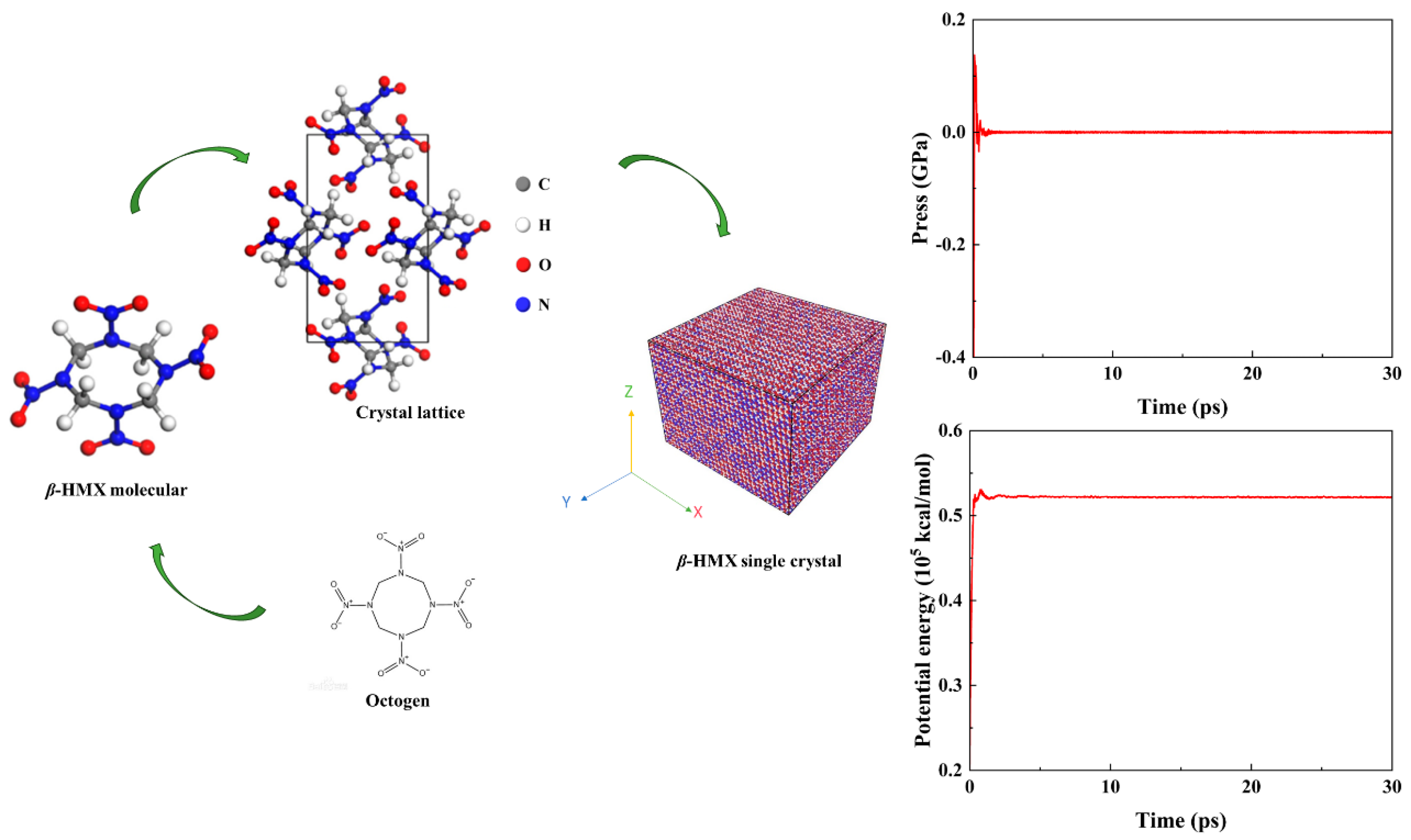
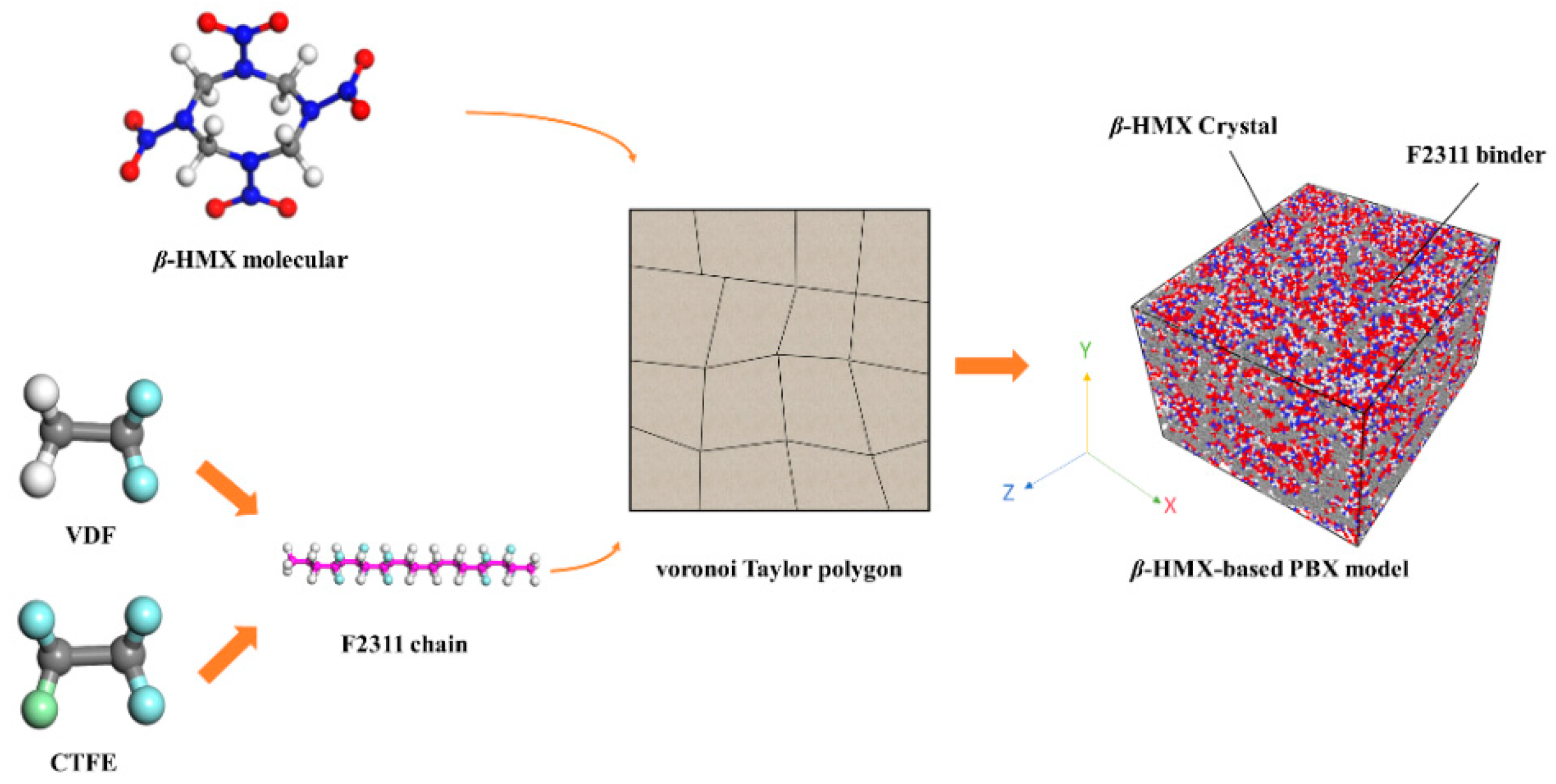
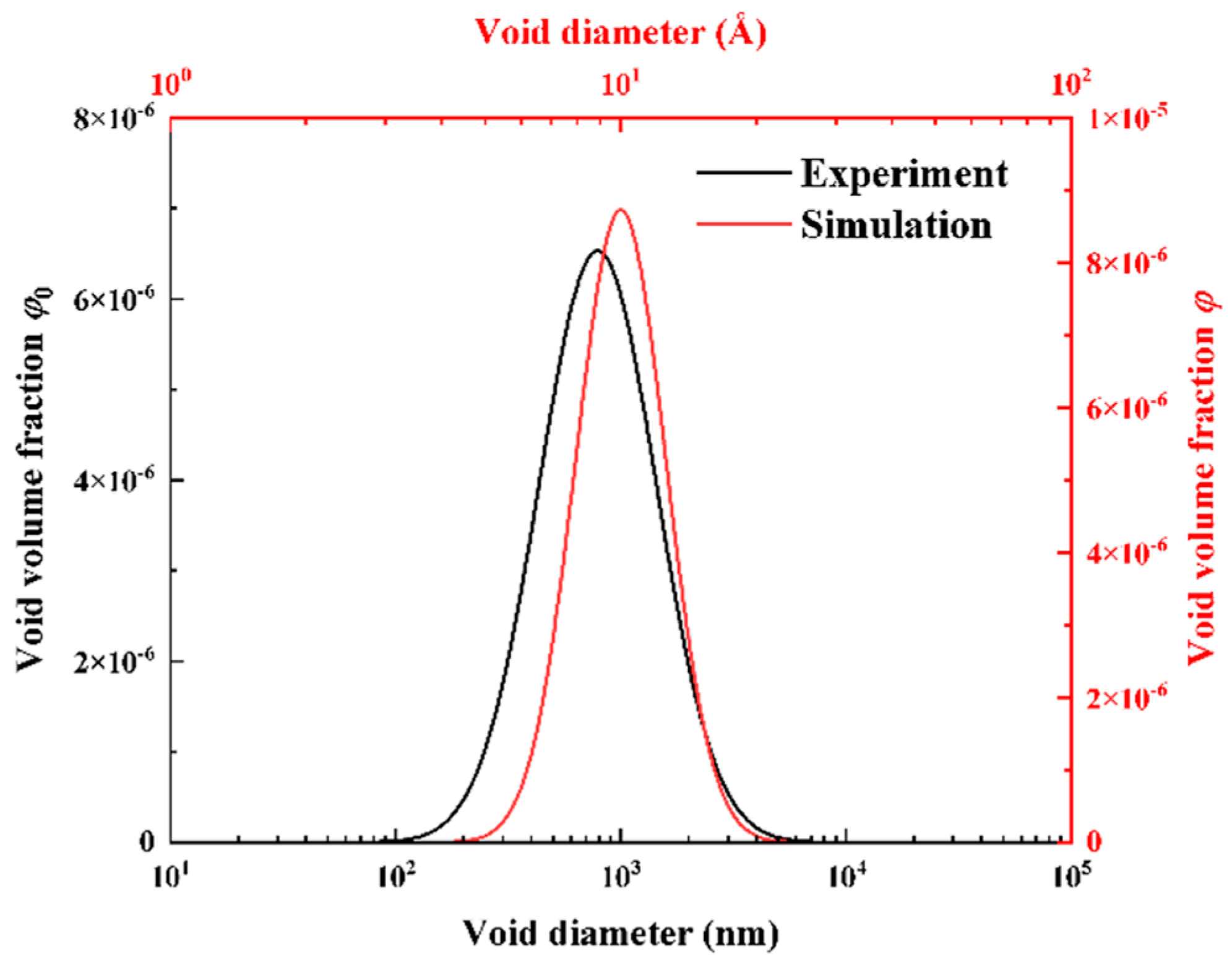
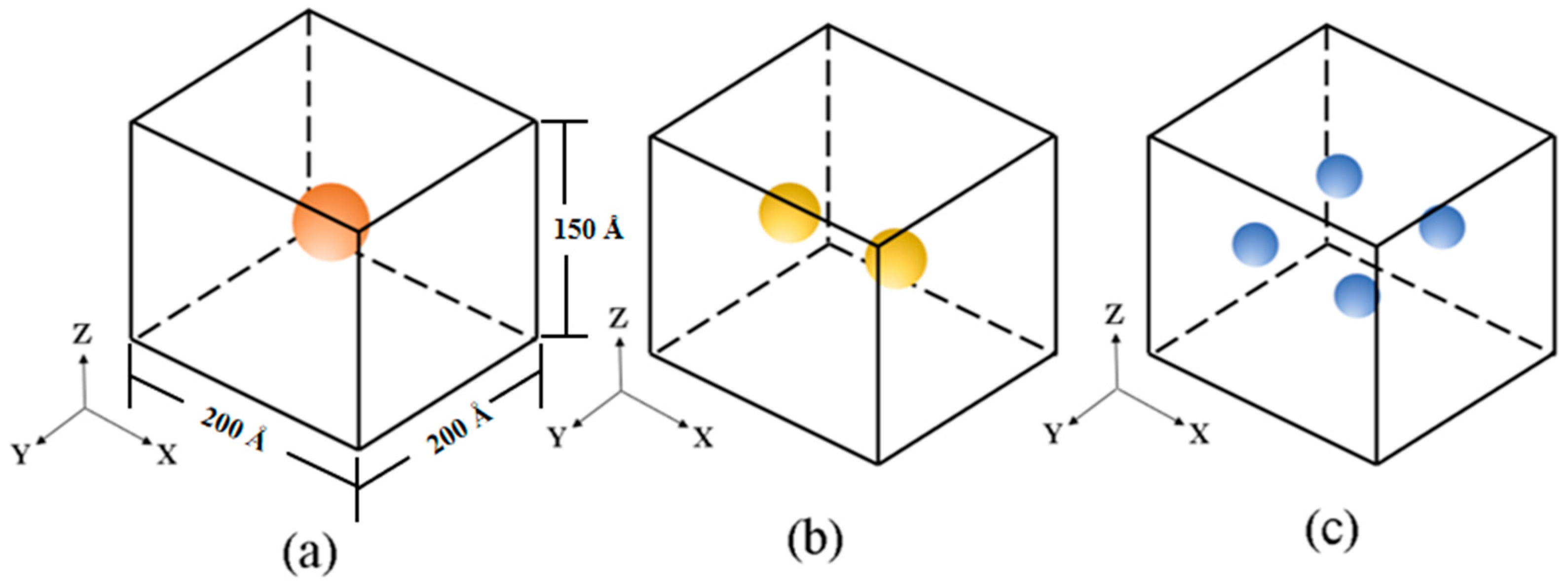
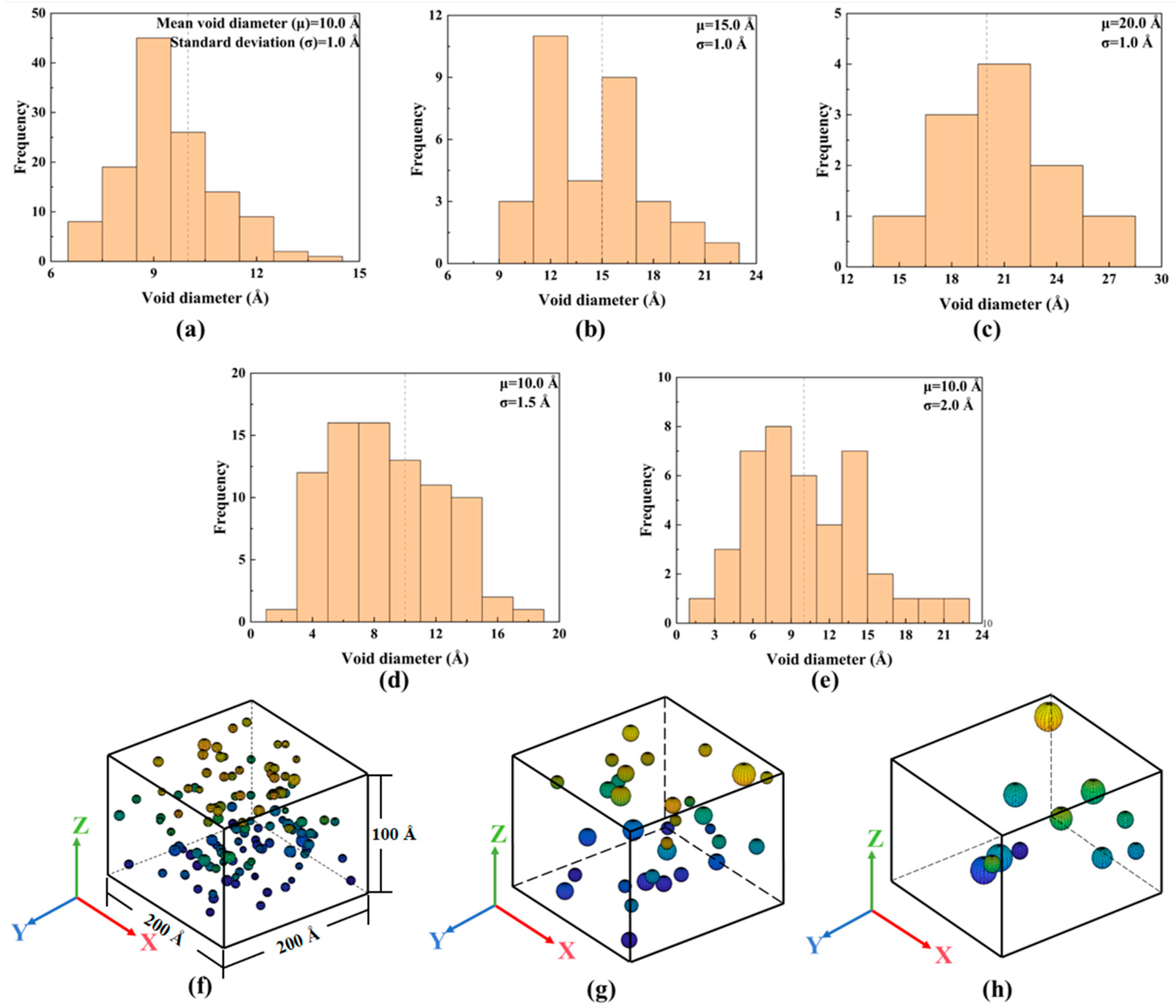
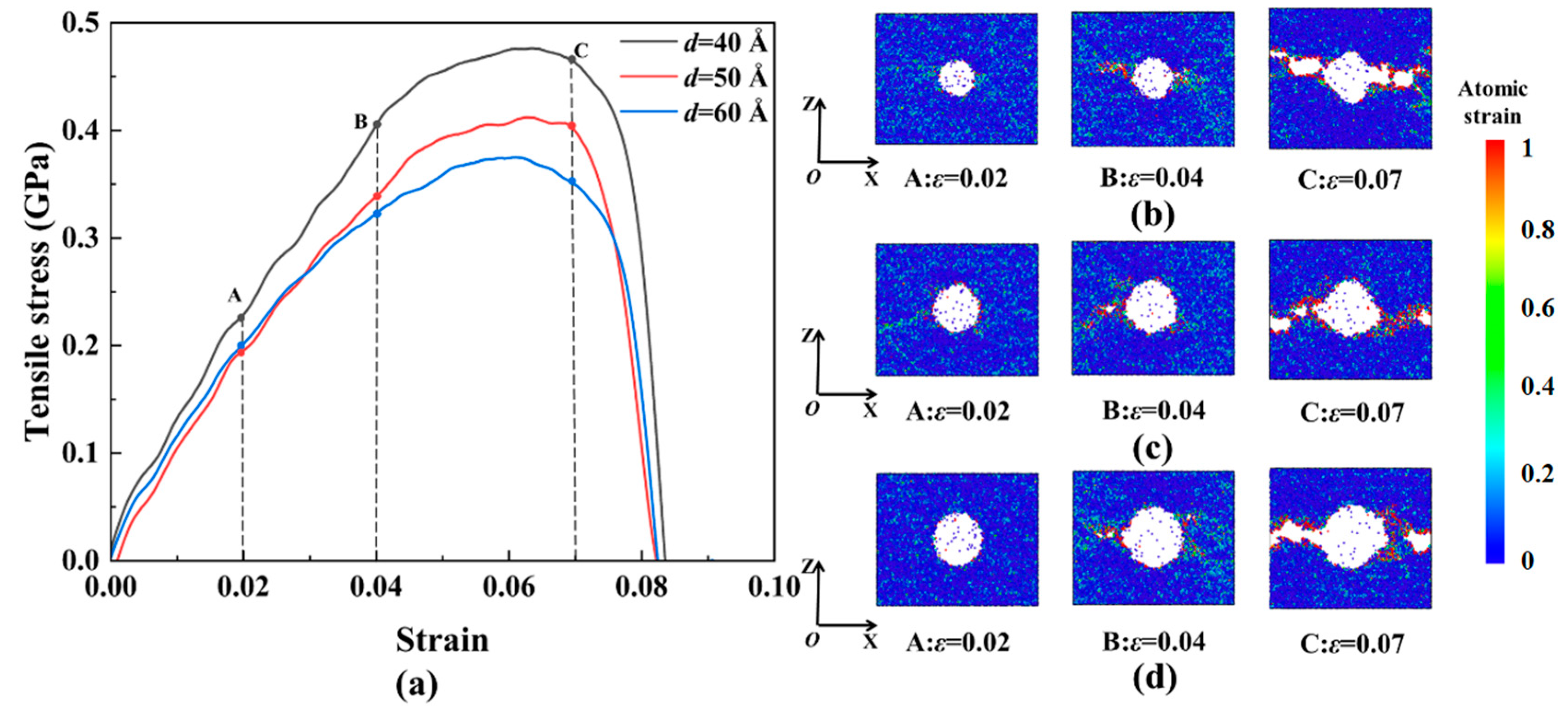

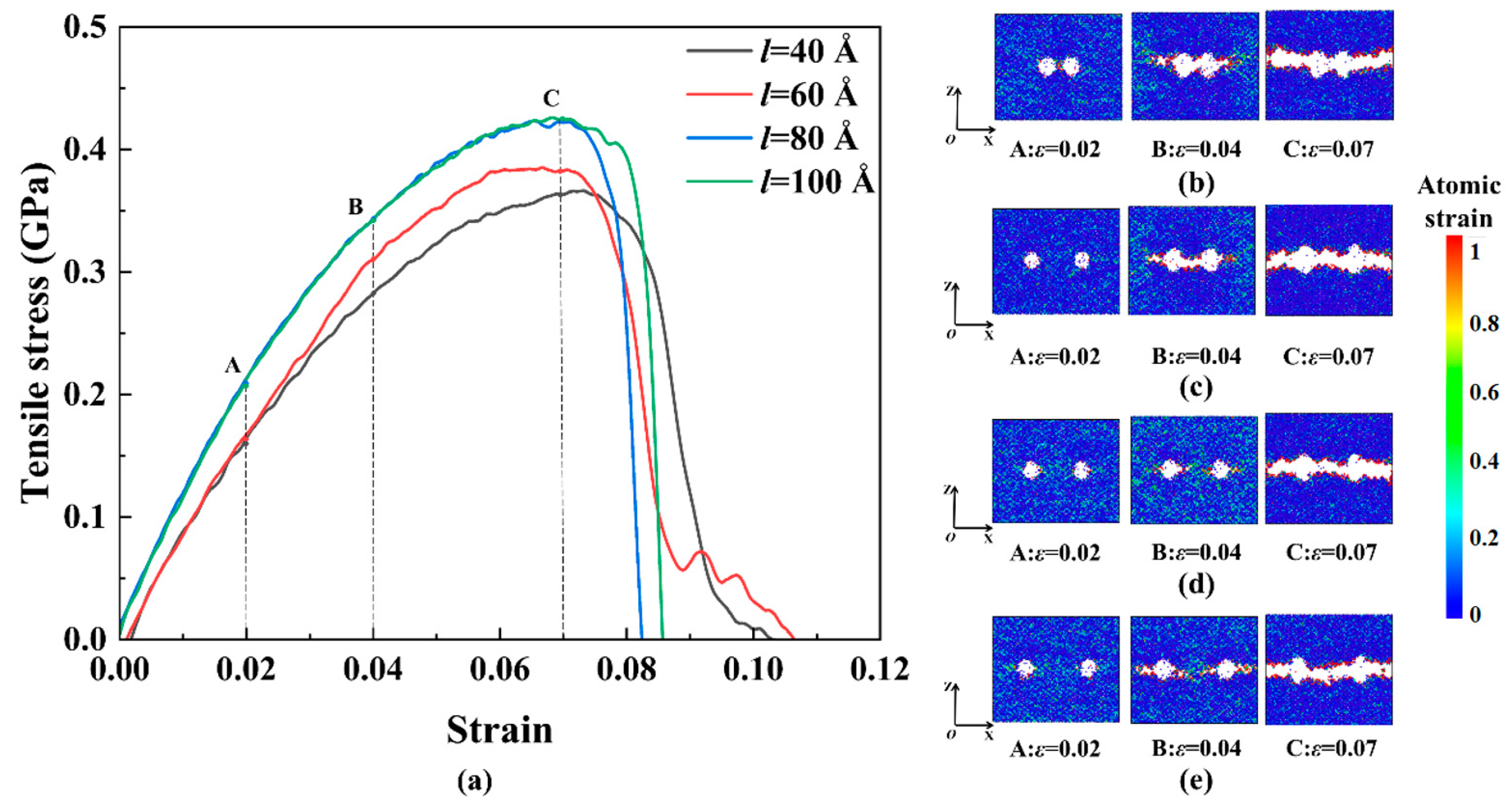
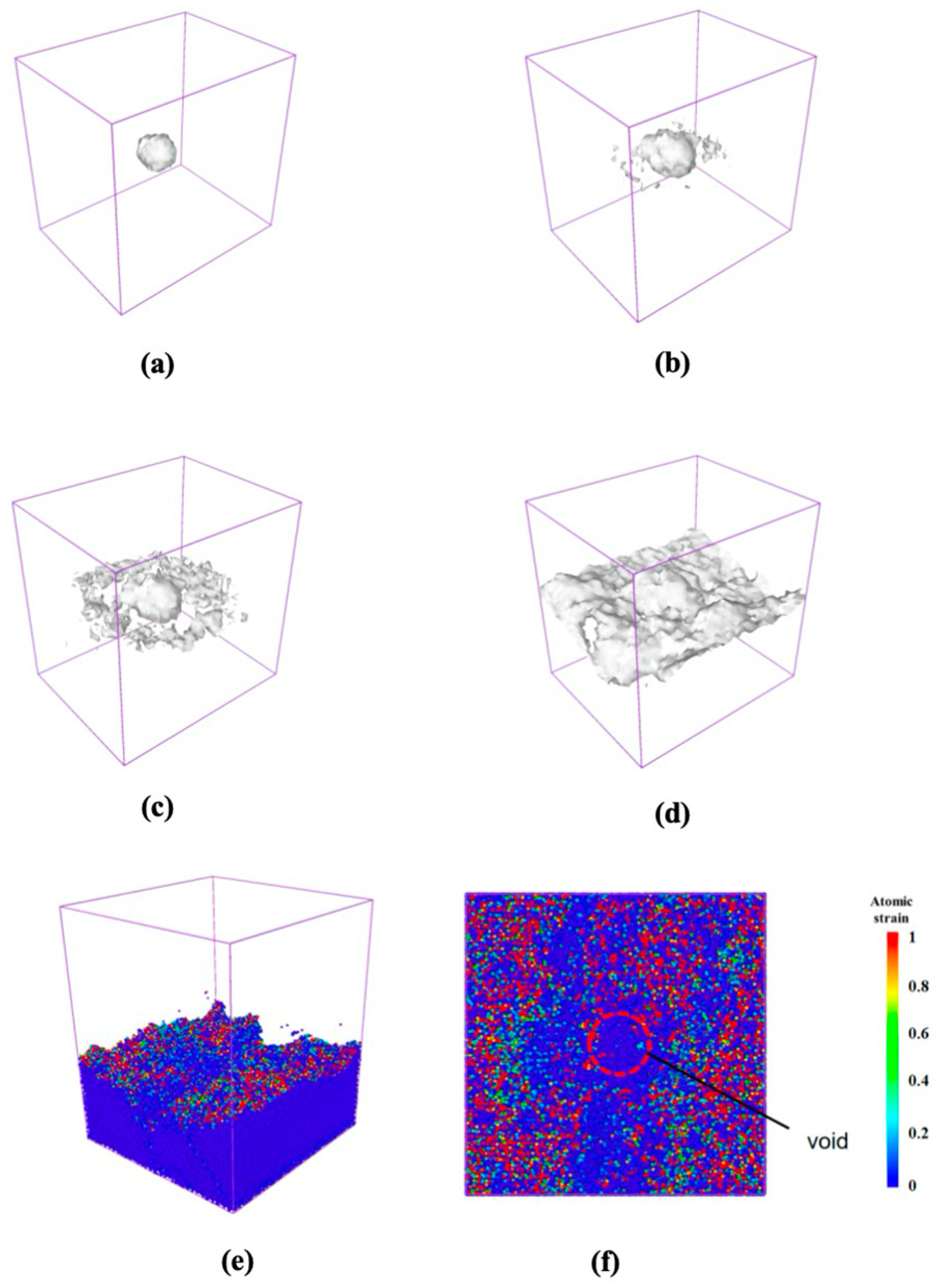
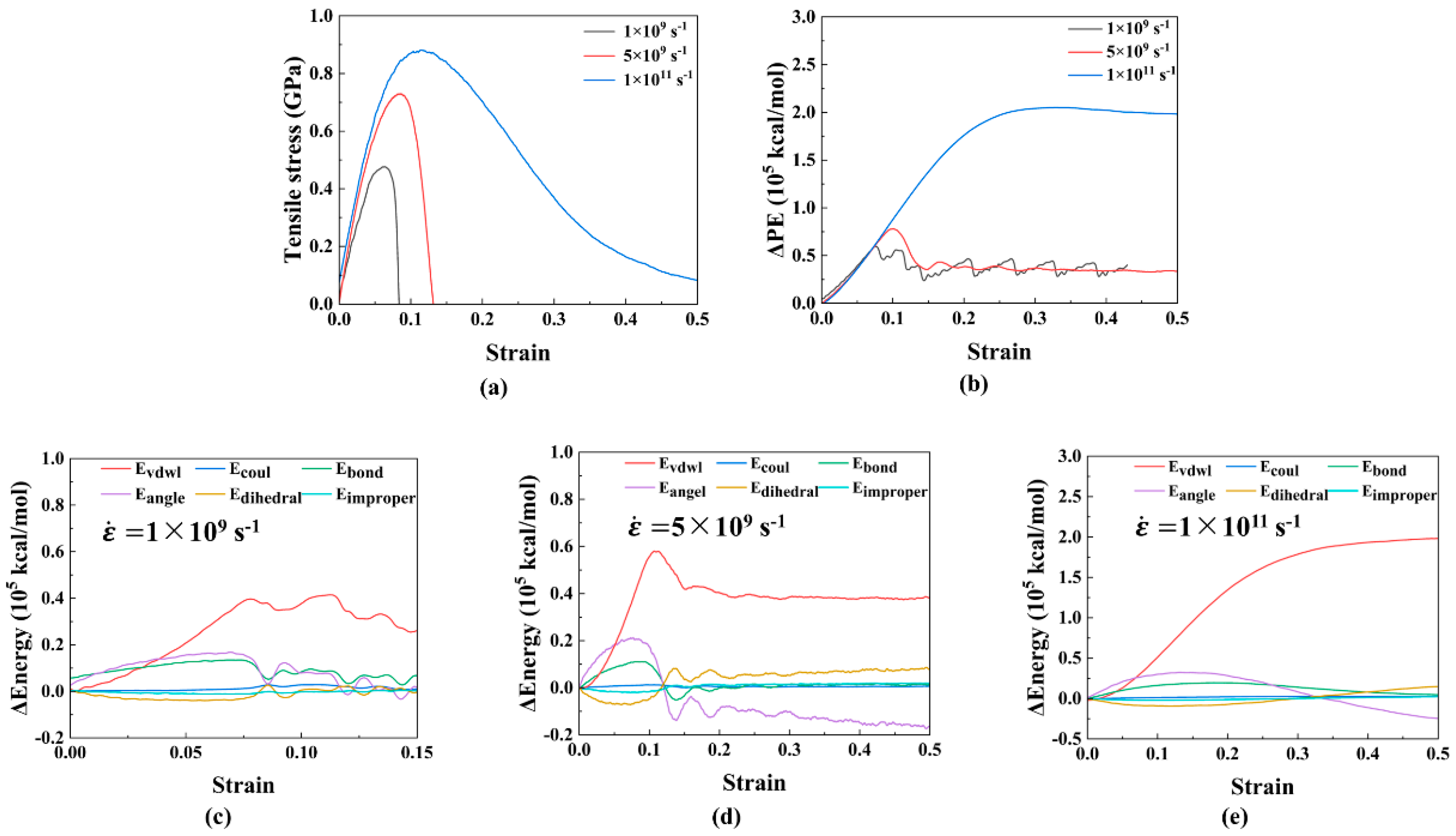
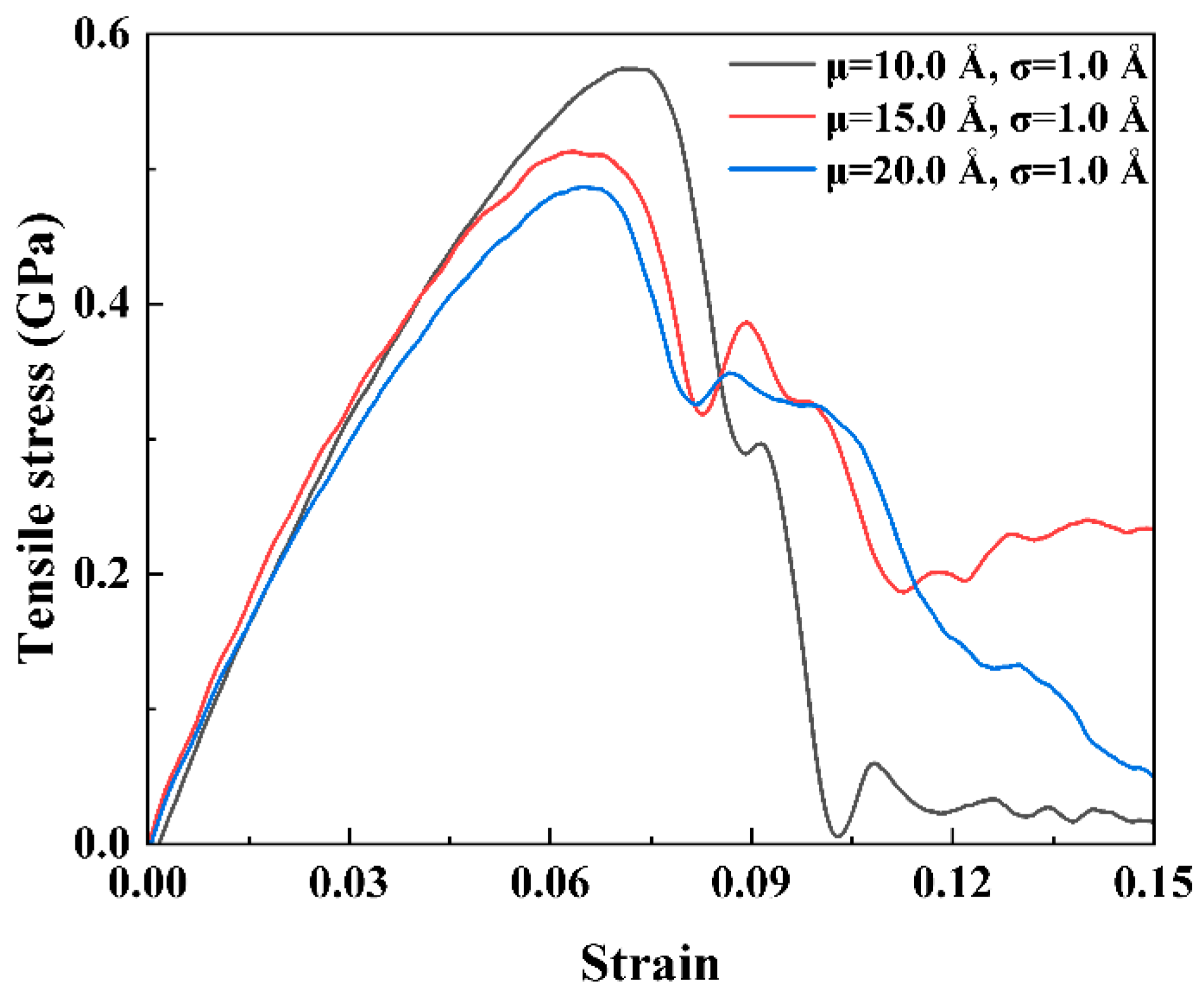
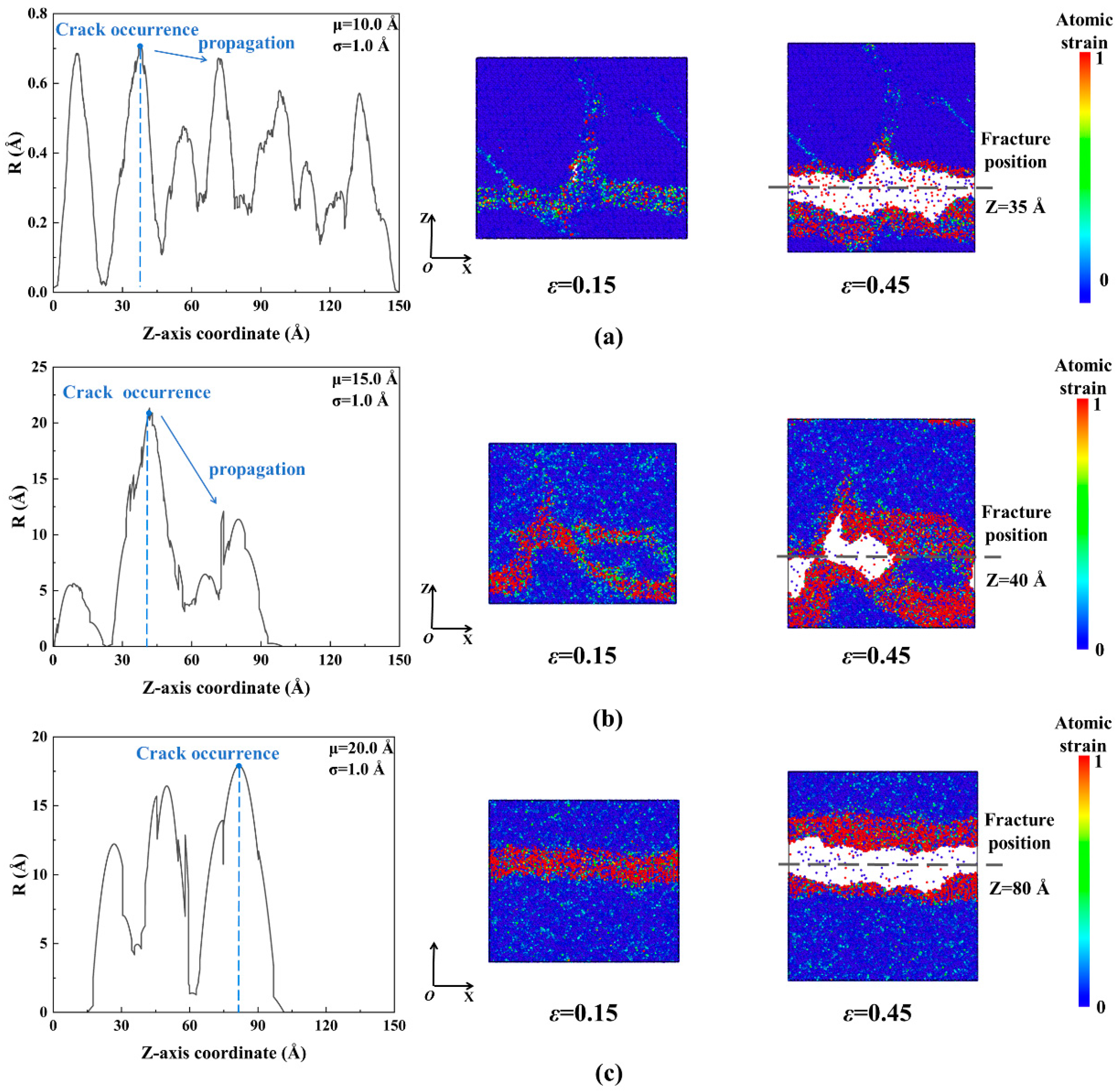
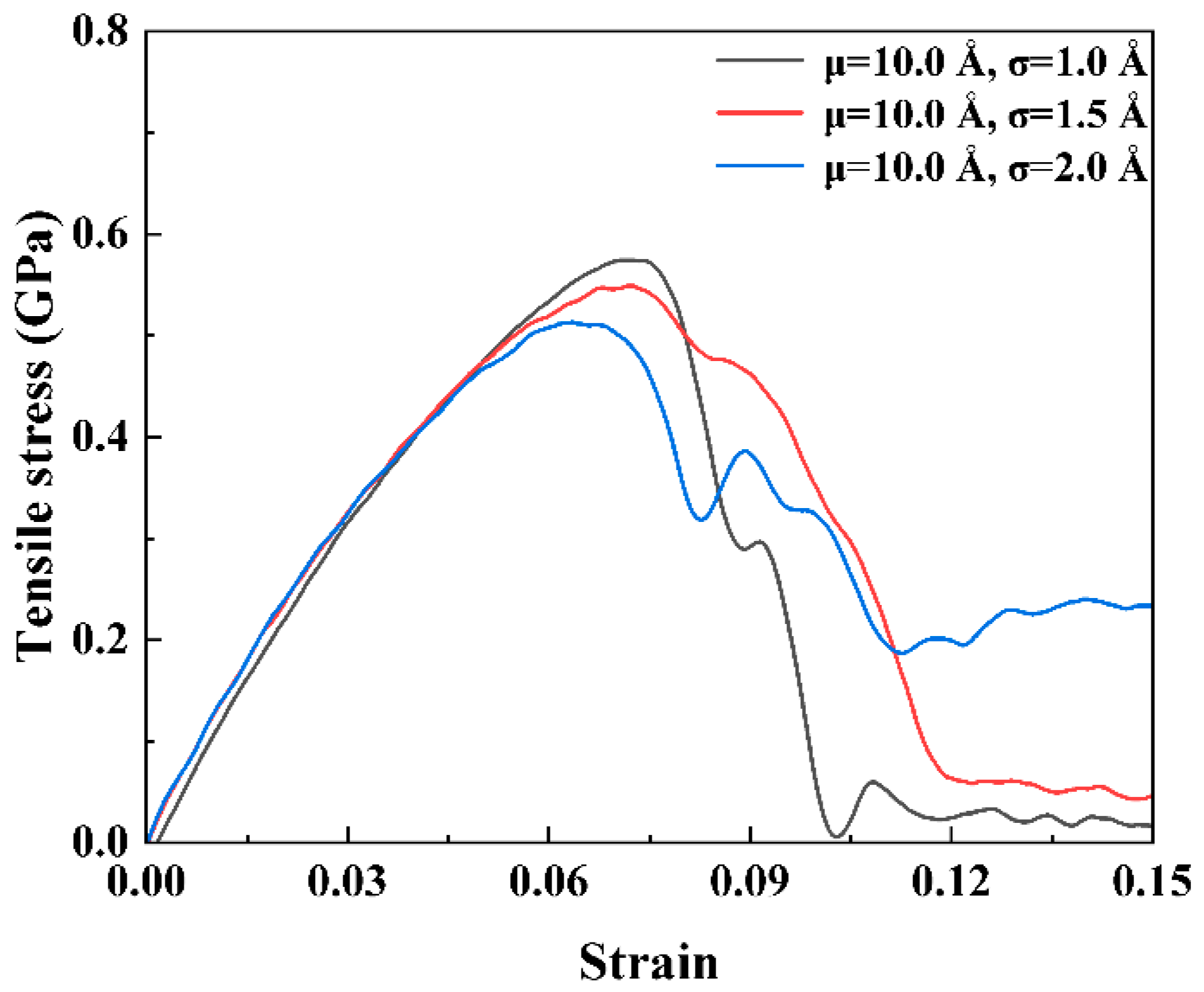
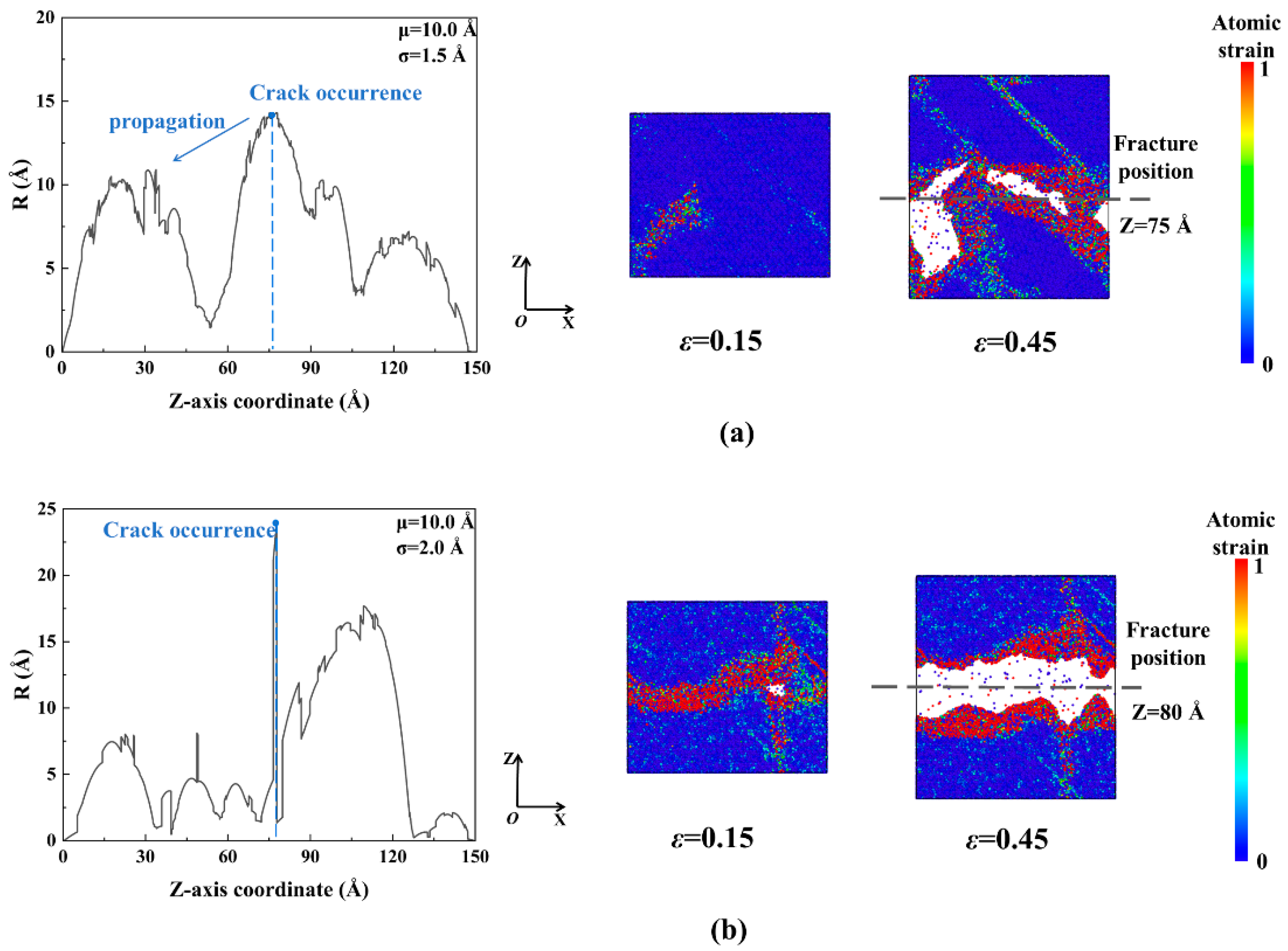

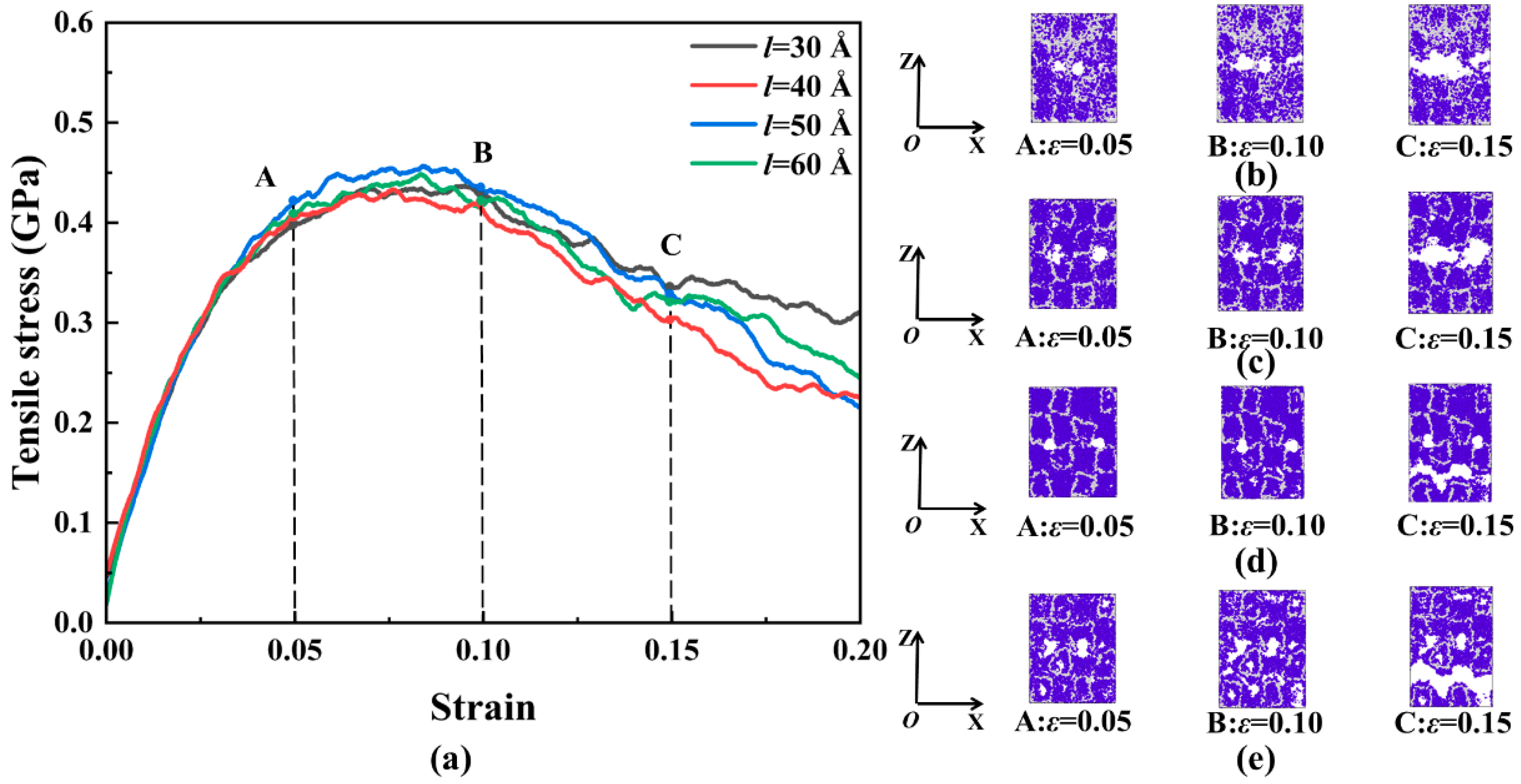
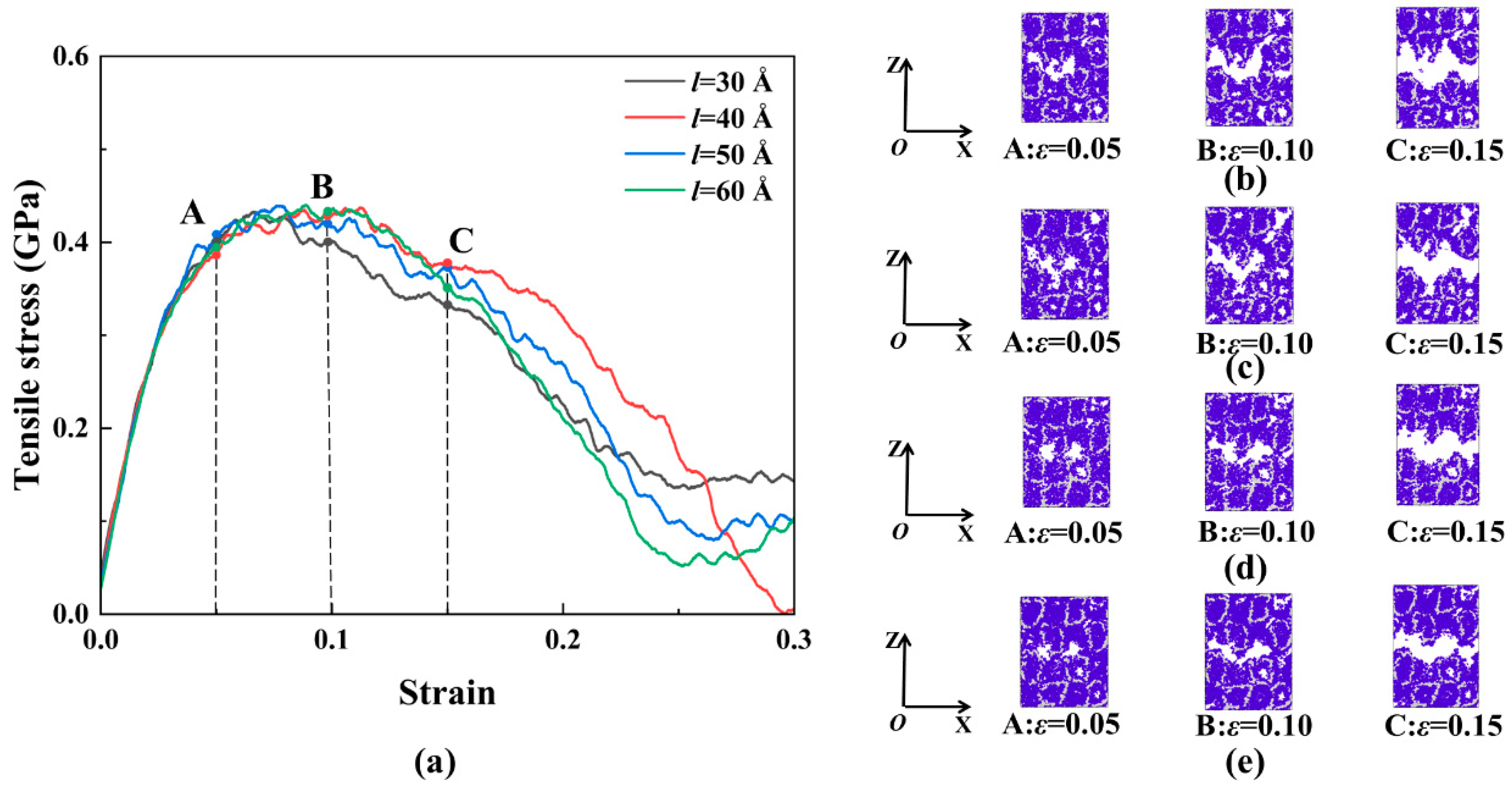
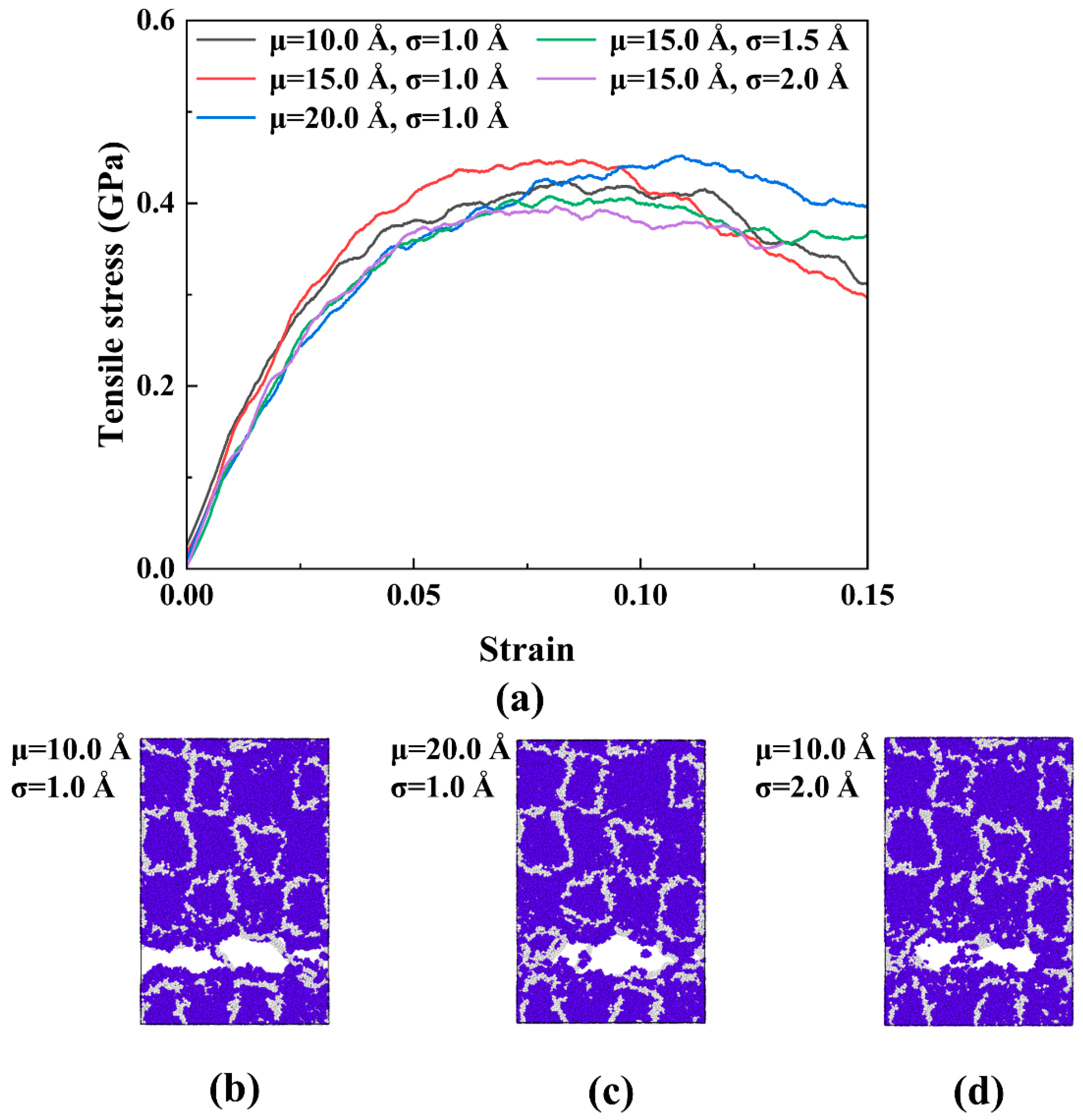
| Lattice Constant Parameter | a/Å | b/Å | c/Å | α | β | γ |
|---|---|---|---|---|---|---|
| Value | 6.54 | 11.05 | 8.7 | 90° | 124.3° | 90° |
| Parameter | Experiment | Simulation |
|---|---|---|
| Young’s modulus/GPa | 17.48 [49] | 14.50 |
| Density/(g·cm3) | 1.904 [50] | 1.829 |
| Void Number | Void Diameter/Å | Porosity in Crystal | Porosity in PBX |
|---|---|---|---|
| 1 | 40.0 | 0.6% | 1.1% |
| 1 | 50.0 | 1.1% | 2.0% |
| 1 | 60.0 | 2.0% | 4.0% |
| 2 | 32.0 | 0.6% | 1.1% |
| 4 | 25.0 | 0.6% | 1.1% |
Disclaimer/Publisher’s Note: The statements, opinions and data contained in all publications are solely those of the individual author(s) and contributor(s) and not of MDPI and/or the editor(s). MDPI and/or the editor(s) disclaim responsibility for any injury to people or property resulting from any ideas, methods, instructions or products referred to in the content. |
© 2025 by the authors. Licensee MDPI, Basel, Switzerland. This article is an open access article distributed under the terms and conditions of the Creative Commons Attribution (CC BY) license (https://creativecommons.org/licenses/by/4.0/).
Share and Cite
Huang, L.; Li, Y.; Wang, Y.; Liu, R.; Chen, P.; Xia, Y. Understanding the Deformation and Fracture Behavior of β−HMX Crystal and Its Polymer−Bonded Explosives with Void Defects on the Atomic Scale. Crystals 2025, 15, 376. https://doi.org/10.3390/cryst15040376
Huang L, Li Y, Wang Y, Liu R, Chen P, Xia Y. Understanding the Deformation and Fracture Behavior of β−HMX Crystal and Its Polymer−Bonded Explosives with Void Defects on the Atomic Scale. Crystals. 2025; 15(4):376. https://doi.org/10.3390/cryst15040376
Chicago/Turabian StyleHuang, Longjie, Yan Li, Yuanjing Wang, Rui Liu, Pengwan Chen, and Yu Xia. 2025. "Understanding the Deformation and Fracture Behavior of β−HMX Crystal and Its Polymer−Bonded Explosives with Void Defects on the Atomic Scale" Crystals 15, no. 4: 376. https://doi.org/10.3390/cryst15040376
APA StyleHuang, L., Li, Y., Wang, Y., Liu, R., Chen, P., & Xia, Y. (2025). Understanding the Deformation and Fracture Behavior of β−HMX Crystal and Its Polymer−Bonded Explosives with Void Defects on the Atomic Scale. Crystals, 15(4), 376. https://doi.org/10.3390/cryst15040376






